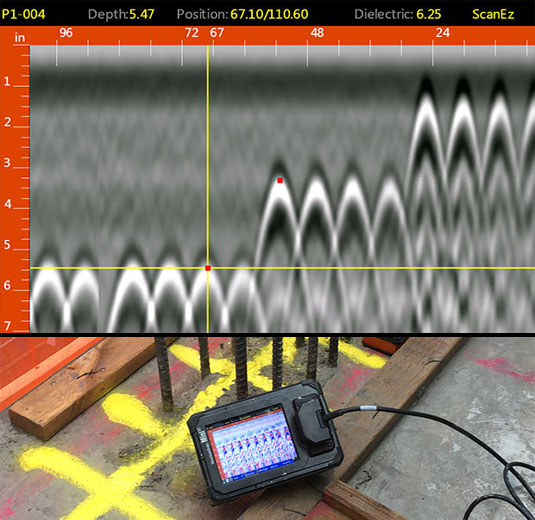Comprehensive Overview to RainierGPR Concrete Scanning Techniques
Comprehensive Overview to RainierGPR Concrete Scanning Techniques
Blog Article
Checking Out the Depths: A Comprehensive Overview to Concrete Scanning and Its Diverse Applications
In the world of building and construction and facilities advancement, the meticulous procedure of concrete scanning holds an essential duty in ensuring the structural integrity and safety and security of tasks. As technology continues to progress, the applications of concrete scanning have actually increased much beyond simple surface-level assessments.
Importance of Concrete Scanning
Comprehending the importance of concrete scanning is important in guaranteeing the safety and integrity of structures throughout construction and improvement tasks. Concrete scanning utilizes advanced innovations such as ground-penetrating radar (GPR) and electromagnetic induction to discover embedded items, spaces, or other abnormalities within concrete structures.
Furthermore, concrete scanning plays a pivotal duty in ensuring compliance with building ordinance and guidelines that mandate the security of existing architectural components during building and construction tasks. By precisely drawing up the interior make-up of concrete, scanning modern technologies make it possible for building and construction experts to make enlightened decisions that promote the architectural stability and sturdiness of buildings and infrastructure projects. Basically, the value of concrete scanning depends on its ability to safeguard both the structural honesty and the personnel entailed in construction ventures.
Technologies Used in Concrete Scanning
Concrete scanning counts on sophisticated technologies such as ground-penetrating radar (GPR) and electro-magnetic induction to properly identify embedded things and anomalies within concrete structures. Ground-penetrating radar runs by releasing high-frequency electro-magnetic waves right into the concrete.
Electro-magnetic induction, on the various other hand, functions by producing magnetic fields around a concrete structure with a transmitter coil. When steel items are existing within the concrete, they interfere with these magnetic fields, creating eddy currents to flow via the metal. By determining the adjustments in the magnetic fields with a receiver coil, the system can pinpoint the location of metal objects in the concrete.
These advanced modern technologies play a critical role in non-destructive testing, making certain the security and honesty of concrete structures in various sectors.
Applications in Building Market
Within the building and construction sector, concrete scanning technology discovers diverse applications that enhance task effectiveness and security. One key application is the discovery of rebar, post-tension cable televisions, and other ingrained items before exploration or cutting right into concrete frameworks. By accurately drawing up these elements, building and construction teams can prevent pricey problems, ensure structural stability, and prevent possible safety threats. Additionally, concrete scanning is made use of for finding spaces, such as air pockets or areas of damage within concrete, which can endanger the total toughness of a structure. By identifying these gaps beforehand, building experts can take necessary steps to resolve them and preserve the resilience of the building. Additionally, concrete scanning plays a critical role in quality assurance by confirming the thickness of concrete covers over reinforcement, making sure compliance with layout specs and standards. Generally, the applications of concrete scanning in the building and construction industry add dramatically to streamlining task operations, lowering threats, and supplying high-quality outcomes.

Safety Advantages of Concrete Scanning
In the realm of building security, the application of concrete scanning modern technology provides a paramount advantage in preemptively identifying potential hazards and strengthening architectural honesty. By using innovative scanning techniques such as ground-penetrating radar (GPR) my blog and electromagnetic induction, building teams can accurately locate rebar, post-tension cords, conduits, and various other covert objects within concrete frameworks. This positive method substantially minimizes the danger of unintended strikes throughout boring, reducing, or coring activities, therefore avoiding expensive problems, injuries, and project hold-ups.
Furthermore, concrete scanning improves employee security by supplying real-time info regarding the structural condition of concrete elements. By addressing potential safety concerns promptly, concrete scanning contributes to producing a safe working environment and minimizing the likelihood of structural failings or mishaps on construction sites.
Future Trends in Concrete Scanning
Arising advancements in scanning modern technology are poised to change the field of concrete evaluation and evaluation. By harnessing the power of AI, these systems can evaluate huge quantities of data gathered during scanning procedures to give more accurate and in-depth understandings right into the problem of concrete structures.
Another significant trend is the development of even more portable and easy to use scanning gadgets. Miniaturization of scanning tools enables less complicated accessibility to confined spaces and remote locations, making inspections extra extensive and efficient. Furthermore, developments in wireless interaction technologies enable real-time information transfer and analysis, assisting in quicker decision-making processes.
Additionally, there is a growing concentrate on sustainability in concrete scanning modern technologies - RainierGPR Concrete Scanning. Suppliers are progressively incorporating eco-friendly materials and energy-efficient attributes into their gadgets to lower ecological effect. These future patterns are set to enhance you can check here the efficiency, accuracy, and sustainability of concrete scanning methods, shaping the sector's future landscape
Conclusion
Finally, concrete scanning plays a critical role in the construction this sector by making sure the security and effectiveness of numerous tasks. By using advanced innovations, such as GPR and radar imaging, professionals have the ability to precisely spot potential hazards within concrete frameworks. The applications of concrete scanning are large and continue to evolve, making it a necessary device for keeping the stability of structures and facilities. As technology advances, the future of concrete scanning holds appealing growths for boosting construction procedures.

Report this page